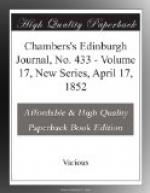The land had been deep turf (peat), and all but useless for agricultural purposes. By drainage, cultivation, and irrigation, however, it was made to produce the finest meadow grass, sold annually by public auction for from L.4 to L.6 per acre; and sometimes it yielded a second, and even a third crop. The great secret of this improvement was, that the then proprietor gave his steward, who was likewise his relation, a permanent interest in his outlay, by letting him the land on lease for ever. In consequence of his doing so, the very worst land, judging by the surface, has been made equal in value to town fields; and in the progress of this work, the wildest race perhaps in the world, have now become a civilised and industrious people. Mr C—— has sold his interest in the improvements for L.10,000, calculated, on the average profit of past years, at twenty years’ purchase.
When he first undertook the work, he had every difficulty to contend with: the people were unused to labour, and so wild and savage, that no stranger dared to settle among them. I was told that when the first land-steward was seen at the chapel in a dress which denoted him to be a stranger, he heard a man behind him telling another in Irish—which he supposed to be unknown to the stranger—the part of his neck in which he would plant a deadly wound before he got home. The steward fortunately understood the native tongue, and quitting the chapel before the service was over, he fled from the dangerous place.
The present civilisation and industrious habits of the people, compared with their barbarism thirty years ago, shews that the Irish character, when properly directed, is as capable of advancement as any other in the world. There was at that time no road into or out of Ballyvourney: it was in this respect like the Happy Valley. The passes are yet in existence, and are fearful to look at, where a gentleman from Kenmare, on his journeys to Cork, used to bring his chariot, accompanied by a number of footmen, and unharnessing the horses, let it down by ropes from the top of the precipice. There is another spot of the kind on the road from Killarney to Cahersiveen and Valentia, where on the side of the Hill of Droum, nearly precipitous from the sea, is the track-mark of the carriage-road, if such it can be called, where the vehicle used to be supported and dragged by men. A new road has since been made there: the Atlantic Ocean is so directly beneath, that a passenger may drop a stone into it as he drives along; while Droum Hill stands perpendicularly above him. It is a most magnificent scene; terminating with the ruins of Daniel O’Connell’s birthplace. Visitors to Ireland usually conclude their journey at Killarney; but if they would continue their route to Caragh Lake, Blackstone, Lady Headley’s improvements, and go on through the Pass of Droum to Valentia and Cahersiveen, they would discover that Killarney is only the opening to a scene of grandeur and sublimity.




